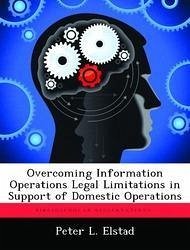Nicht lieferbar

National Guard Intelligence Support to Domestic Operations
Versandkostenfrei!
Nicht lieferbar
The commission formed after the terrorist attacks of September 11, 2001 identified a need for a better domestic intelligence capability, and policy decisions since then have directed increased information sharing between the intelligence community and the collective law enforcement community. This also brings into question the role of military intelligence within domestic operations, and specifically the role and relationships of the National Guard within the framework of state and local intelligence fusion centers. In order to understand the limits of military intelligence support to domestic...
The commission formed after the terrorist attacks of September 11, 2001 identified a need for a better domestic intelligence capability, and policy decisions since then have directed increased information sharing between the intelligence community and the collective law enforcement community. This also brings into question the role of military intelligence within domestic operations, and specifically the role and relationships of the National Guard within the framework of state and local intelligence fusion centers. In order to understand the limits of military intelligence support to domestic operations, an appreciation of the history of intelligence oversight and the policy, directives, and regulations covering military intelligence support is necessary. To be able to predict future trends requires a review of the changes to intelligence sharing brought about by the attacks of September 11, 2001. This monograph outlines how the new operational environment, which includes the establishment of a new combatant command and the establishment of the Department of Homeland Security affects domestic intelligence operations through a review of current regulations and policies affecting domestic intelligence operations. This monograph advocates provision of intelligence support to established state level intelligence centers by each state's National Guard. Because of current legal restrictions, this support should be predominantly through information sharing; with the National Guard assets serving as a two-way conduit for information between the intelligence community and the state intelligence fusion centers. It is beneficial to the each state's National Guard Joint Forces Headquarters via increased level of situational awareness which will occur due to the assets physical presence in the fusion centers. This can be accomplished with little change to existing regulation due to the requirement to maintain a common operating picture. This will require the management of a do










